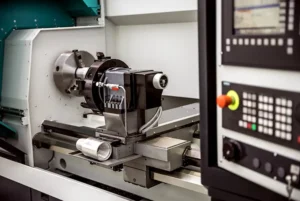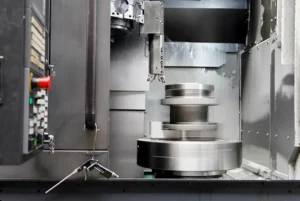In today’s manufacturing world, the CNC machine has become an indispensable core device. By using computer programs for control, CNC machines achieve high-precision and efficient part machining, greatly advancing automation and intelligence in industrial production. Five-axis CNC machines, in particular, offer multi-degree-of-freedom movement, enabling the processing of complex surfaces and irregular parts. These machines are widely used in aerospace, automotive, mold manufacturing, and many other industries.
However, not all 5-axis CNC machines are the same. Among the most common and discussed designs are the double swing head (B+C axis) and single swing head structures. They differ significantly in structure, machining capability, and application scope. For B2B customers, understanding these differences is essential for making informed purchasing decisions based on production needs and budget.
This article focuses on the keyword “CNC machine” and provides an in-depth comparison between double swing head and single swing head structures. We’ll also incorporate relevant long-tail keywords to help you fully understand both options and make the best choice for your business.
Basics of Five-Axis CNC Machine
A five-axis CNC machine adds two rotational axes (usually B and C) to the conventional XYZ axes, allowing for five degrees of simultaneous movement. This enables the machine to complete complex, multi-face part machining in a single setup, greatly improving efficiency and accuracy.
Common five-axis CNC machine structures include:
- Double swing head (B+C axis): The spindle head rotates around two axes, while the worktable remains fixed.
- Single swing head: The spindle head rotates around just one axis, with a fixed or rotating worktable.
- Other types, such as double rotary tables.
Each structure has its own advantages and is suitable for different machining requirements.
Double Swing Head Structure (B+C Axis) Explained
CNC Machine How It Works
A double swing head CNC machine features a spindle that can rotate around both the B and C axes, while the worktable remains stationary. This design allows the spindle to approach the workpiece from multiple angles, making it ideal for machining complex surfaces.
Advantages
- Perfect for Large and Heavy Workpieces: The stationary worktable makes clamping and positioning easier, especially for large aerospace, automotive mold, or wind turbine blade parts.
- Wide Machining Range: The dual-axis swinging spindle offers exceptional flexibility, enabling five-face or even multi-face machining of irregular parts.
- High Precision: Keeping the workpiece still reduces errors caused by movement, ensuring machining accuracy.
Disadvantages
- Lower Spindle Rigidity: The double swing head design adds weight and complexity to the spindle, reducing rigidity and limiting heavy cutting capacity.
- Complex Structure and Higher Maintenance: The mechanical structure is complicated, making maintenance more difficult and costly. The equipment price is also higher.
Single Swing Head Structure Explained
How It Works
A single swing head CNC machine has a spindle that rotates around only one axis (usually the B axis), with a fixed or rotating worktable. This design is simpler and provides better spindle rigidity.
Advantages
- Simple Structure, High Rigidity: The lighter spindle head offers greater rigidity, making it suitable for heavy-duty and high-speed cutting.
- Lower Cost: Manufacturing and maintenance costs are lower compared to double swing head designs, making it ideal for batch production of small and medium-sized parts.
- Versatile: Capable of handling a wide range of conventional five-face machining tasks.
Disadvantages
- Limited Workpiece Size: The movement range of the worktable or spindle restricts the maximum size of workpieces.
- Less Flexibility for Complex Surfaces: Compared to double swing head structures, it is less capable of machining highly complex or irregular parts.

CNC Machine Double Swing Head vs. Single Swing Head: A Side-by-Side Comparison
| Comparison Aspect | Double Swing Head (B+C Axis) | Single Swing Head |
|---|---|---|
| Workpiece Size | Suitable for large, heavy parts | Suitable for small/medium parts |
| Spindle Rigidity | Lower, limited heavy cutting | Higher, supports heavy cutting |
| Structural Complexity | Complex, harder to maintain | Simple, easy maintenance |
| Machining Flexibility | High, great for complex shapes | Moderate, for standard parts |
| Typical Applications | Aerospace, automotive molds, wind power | Precision parts, batch production |
| Purchase Cost | Higher | Lower |
| Keyword Examples | large CNC machine, 5 axis CNC head | compact CNC machine, single head CNC |
CNC Machine Buying Advice and Selection Tips
With so many CNC machine structures available, you might wonder: “Which one should I choose?” Here are some key points to consider:
- Workpiece Size and Weight
If your parts are large, heavy, and complex, the double swing head structure is the ideal choice. It ensures stability and reduces deformation risk. - Machining Precision and Complexity
For high-precision, multi-face, or complex machining, the double swing head offers more advantages. For standard parts, the single swing head is usually sufficient. - Budget and Maintenance Costs
If your budget is limited and you want the best value, the single swing head structure is more suitable. The double swing head is pricier but fits high-end applications. - Production Volume and Efficiency
For batch production with a focus on speed, the single swing head’s rigidity and efficiency stand out. For small-batch, complex parts, consider the double swing head. - After-Sales Service and Support
Choose a supplier with strong after-sales and technical support to ensure long-term, stable operation of your equipment.
Choosing the right CNC machine structure is a crucial step in boosting production efficiency and product quality. The double swing head (B+C axis) stands out for its flexibility and ability to handle large, complex workpieces, making it the top choice for advanced manufacturing. Meanwhile, the single swing head wins over the small and medium part market with its high rigidity, lower cost, and broad applicability.
Whether you’re seeking ultimate precision or the best value, understanding the differences between these two structures will help you make a smarter purchasing decision. Feel free to contact us for tailored CNC solutions and let us help you take your production to the next level!
If you have any questions about choosing a CNC machine, or if you want to learn more about the applications of double swing head and single swing head structures, leave a comment or send us an inquiry. Our expert team is ready to provide one-on-one professional support. Let’s work together for a brighter future in manufacturing!





